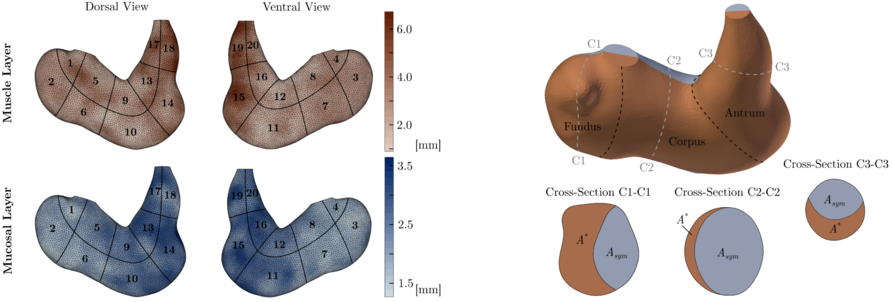The stomach is a vital organ responsible for food storage, digestion, and transport. Stomach diseases are of great economic and medical importance and require a large number of bariatric surgeries every year. To improve medical interventions, in silico modeling of the gastrointestinal tract has gained popularity in recent years to study stomach functioning. Because of the great structural and nutritional similarity between the porcine and human stomach, the porcine stomach is a suitable surrogate for the development and validation of gastric models. This study presents a realistic 3D geometry model of the porcine stomach based on a photogrammetric reconstruction of a real organ. Layer thicknesses of the stomach wall’s mucosa and tunica muscularis were determined by more than 1900 manual measurements at different locations. Layer thickness distributions show mean mucosal and muscle thicknesses of 2.29±0.45 mm and 2.83±0.99 mm, respectively. In general, layer thicknesses increase from fundus (mucosa: 1.82±0.19 mm, muscle layer: 2.59±0.32 mm) to antrum (mucosa: 2.69±0.31 mm, muscle layer: 3.73±1.05 mm). The analysis of stomach asymmetry with respect to an idealized symmetric stomach model, an approach often used in the literature, revealed volumetric deviations of 45%, 15%, and 92% for the antrum, corpus, and fundus, respectively. The present work also suggests an algorithm for the computation of longitudinal and circumferential directions at local points. These directions are useful for the implementation of material anisotropy. In addition, we present data on the pressure-volume relationship of the passive organ and perform an exemplary finite-element simulation, where we showcase the model’s applicability for material parameter optimization. We encourage others to utilize the geometry model featuring profound asymmetry for future model-based investigations on stomach functioning.
S. Papenkort, M. Borsdorf, T. Siebert, M. Böl
A geometry model of the porcine stomach featuring mucosa and muscle layer thicknesses
Journal of the Mechanical Behavior of Biomedical Materials, in press, (2023)

